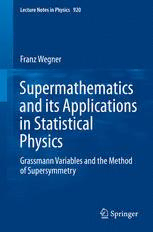Table Of ContentLecture Notes in Physics 920
Franz Wegner
Supermathematics
and its Applications
in Statistical
Physics
Grassmann Variables and the Method
of Supersymmetry
Lecture Notes in Physics
Volume 920
FoundingEditors
W.Beiglböck
J.Ehlers
K.Hepp
H.Weidenmüller
EditorialBoard
M.Bartelmann,Heidelberg,Germany
B.-G.Englert,Singapore,Singapore
P.HaRnggi,Augsburg,Germany
M.Hjorth-Jensen,Oslo,Norway
R.A.L.Jones,Sheffield,UK
M.Lewenstein,Barcelona,Spain
H.vonLoRhneysen,Karlsruhe,Germany
J.-M.Raimond,Paris,France
A.Rubio,Donostia,SanSebastian,Spain
M.Salmhofer,Heidelberg,Germany
S.Theisen,Potsdam,Germany
D.Vollhardt,Augsburg,Germany
J.D.Wells,AnnArbor,USA
G.P.Zank,Huntsville,USA
The Lecture Notes in Physics
The series Lecture Notes in Physics (LNP), founded in 1969, reports new devel-
opmentsin physicsresearch and teaching-quicklyand informally,but with a high
qualityand the explicitaim to summarizeand communicatecurrentknowledgein
anaccessibleway.Bookspublishedinthisseriesareconceivedasbridgingmaterial
between advanced graduate textbooks and the forefront of research and to serve
threepurposes:
(cid:129) to be a compact and modern up-to-date source of reference on a well-defined
topic
(cid:129) to serve as an accessible introduction to the field to postgraduate students and
nonspecialistresearchersfromrelatedareas
(cid:129) to be a source of advanced teaching material for specialized seminars, courses
andschools
Bothmonographsandmulti-authorvolumeswillbeconsideredforpublication.
Editedvolumesshould,however,consistofaverylimitednumberofcontributions
only.ProceedingswillnotbeconsideredforLNP.
VolumespublishedinLNParedisseminatedbothinprintandinelectronicfor-
mats,theelectronicarchivebeingavailableatspringerlink.com.Theseriescontent
isindexed,abstractedandreferencedbymanyabstractingandinformationservices,
bibliographicnetworks,subscriptionagencies,librarynetworks,andconsortia.
Proposalsshouldbe sent to a memberof the EditorialBoard, ordirectly to the
managingeditoratSpringer:
ChristianCaron
SpringerHeidelberg
PhysicsEditorialDepartmentI
Tiergartenstrasse17
69121Heidelberg/Germany
christian.caron@springer.com
Moreinformationaboutthisseriesathttp://www.springer.com/series/5304
Franz Wegner
Supermathematics
and its Applications
in Statistical Physics
Grassmann Variables and the Method
of Supersymmetry
123
FranzWegner
InstitutfuRrTheoretischePhysik
UniversitaRtHeidelberg
Heidelberg,Germany
ISSN0075-8450 ISSN1616-6361 (electronic)
LectureNotesinPhysics
ISBN978-3-662-49168-3 ISBN978-3-662-49170-6 (eBook)
DOI10.1007/978-3-662-49170-6
LibraryofCongressControlNumber:2016931278
SpringerHeidelbergNewYorkDordrechtLondon
©Springer-VerlagBerlinHeidelberg2016
Thisworkissubjecttocopyright.AllrightsarereservedbythePublisher,whetherthewholeorpartof
thematerialisconcerned,specificallytherightsoftranslation,reprinting,reuseofillustrations,recitation,
broadcasting,reproductiononmicrofilmsorinanyotherphysicalway,andtransmissionorinformation
storageandretrieval,electronicadaptation,computersoftware,orbysimilarordissimilarmethodology
nowknownorhereafterdeveloped.
Theuseofgeneraldescriptivenames,registerednames,trademarks,servicemarks,etc.inthispublication
doesnotimply,evenintheabsenceofaspecificstatement,thatsuchnamesareexemptfromtherelevant
protectivelawsandregulationsandthereforefreeforgeneraluse.
Thepublisher,theauthorsandtheeditorsaresafetoassumethattheadviceandinformationinthisbook
arebelievedtobetrueandaccurateatthedateofpublication.Neitherthepublishernortheauthorsor
theeditorsgiveawarranty,expressorimplied,withrespecttothematerialcontainedhereinorforany
errorsoromissionsthatmayhavebeenmade.
Printedonacid-freepaper
Springer International Publishing AG Switzerland is part of Springer Science+Business Media
(www.springer.com)
To Anne-Gret,
Annette, andChristian
Preface
This book arose from my interest in disordered systems. It was known, for some
time,thatdisorderinaone-particleHamiltonianusuallyleadstolocalizedstatesin
one-dimensionalchains.Andersonhadarguedthatinhigher-dimensionalsystems,
theremayberegionsoflocalizedandextendedstates,separatedbyamobilityedge.
In1979and1980,itbecameclearthatthisAndersontransitioncouldbedescribed
intermsofanonlinearsigmamodel.LotharSchäferandmyselfreducedthemodel
to one described by interacting matrices by means of the replica trick. Efetov,
Larkin,and Khmel’nitskiiperformeda similar calculation. They,however,started
fromadescriptionbymeansofanticommutingcomponents.In1982Efetovshowed
that a formulation without the replica trick was possible using supervectors and
supermatriceswithequalnumberofcommutingandanticommutingcomponents.
I hadthe pleasureof givingmanylecturesandseminarson disorderedsystems
and critical systems, and also on fermionic systems, where Grassmann variables
playanessentialrole.AmongthemwereseminarsintheSonderforschungsbereich
(collaborativeresearchcenter)onstochasticmathematicalmodelswithmathemati-
cians and physicists and in the Graduiertenkolleg (research training group) on
physical systems with many degrees of freedom and seminars with Heinz Horner
andChristofWetterich.Inparticular,IrememberaseminarwithGüntherDoschon
Grassmannvariablesinstatisticalmechanicsandfieldtheory.
Some of the applicationsof Grassmann variablesare presented in this volume.
Thebookisintendedforphysicists,whohaveabasicknowledgeoflinearalgebra
and the analysis of commuting variables and of quantum mechanics. It is an
introductory book into the field of Grassmann variables and its applications in
statisticalphysics.
The algebra and analysis of Grassmann variables is presented in Part I. The
mathematicsofthesevariablesisappliedtoarandommatrixmodel,topathintegrals
forfermions(incomparisontothe pathintegralsforbosons)andto dimermodels
andtheIsingmodelintwodimensions.
Supermathematics, that is, the use of commuting and anticommuting variables
on an equal footing, is the subject of Part II. Supervectors and supermatri-
ces, which contain both commuting and Grassmann components, are introduced.
vii
viii Preface
In Chaps.10–14, the basic formulae for such matrices and the generalization of
symmetric,real, unitary,andorthogonalmatricesto supermatricesare introduced.
Chapters 15–17 contain a number of integral theorems and some additional
information on supermatrices. In many cases, the invariance of functions under
certaingroupsallowsthereductionoftheintegralstothosewherethesamenumber
ofcommutingandanticommutingcomponentsiscanceled.
In Part III, supersymmetric physical models are considered. Supersymmetry
appearedfirstinparticlephysics.Ifthissymmetryexists,thenbosonsandfermions
exist with equal masses. So far, they have not been discovered. Thus, either this
symmetrydoesnotexistoritisbroken.Theformalintroductionofanticommuting
space-timecomponents,however,canalsobeusedinproblemsofstatisticalphysics
and yields certain relations or allows the reduction of a disordered system in d
dimensionsto a pure system in d (cid:2)2 dimensions. Since supersymmetryconnects
stateswithequalenergies,ithasalsofounditswayintoquantummechanics,where
pairs of Hamiltonians, Q(cid:2)Q and QQ(cid:2), yield the same excitation spectrum. Such
modelsareconsideredinChaps.18–20.
In Chap.21, the representation of the random matrix model by the nonlinear
sigma model and the determination of the density of states and of the level
correlation are given. The diffusive model, that is, the tight-binding model with
random on-site and hopping matrix elements, is considered in Chap.22. These
models show collective excitations called diffusions and if time-reversal holds,
alsocooperons.Chapter23discussesthemobilityedgebehaviorandgivesashort
account of the ten symmetry classes of disorder, of two-dimensional disordered
models,andofsuperbosonization.
I acknowledge useful comments by Alexander Mirlin, Manfred Salmhofer,
Michael Schmidt, Dieter Vollhardt, Hans-Arwed Weidenmüller, Kay Wiese, and
MartinZirnbauer.VirafMehtakindlymadesomeimprovementstothewording.
Heidelberg,Germany FranzWegner
September2015
Contents
PartI GrassmannVariablesandApplications
1 Introduction................................................................. 3
1.1 History................................................................ 3
1.2 Applications.......................................................... 4
References.................................................................... 5
2 GrassmannAlgebra........................................................ 7
2.1 ElementsoftheAlgebra ............................................. 7
2.2 EvenandOddElements,GradedAlgebra .......................... 8
2.3 BodyandSoul,Functions............................................ 10
2.4 ExteriorAlgebraI.................................................... 10
References.................................................................... 12
3 GrassmannAnalysis........................................................ 13
3.1 Differentiation........................................................ 13
3.2 Integration............................................................ 15
3.3 GaussIntegralsI...................................................... 16
3.4 ExteriorAlgebraII................................................... 21
References.................................................................... 27
4 DisorderedSystems......................................................... 29
4.1 Introduction........................................................... 29
4.2 ReplicaTrick ......................................................... 30
4.2.1 FirstVariant................................................. 30
4.2.2 SecondVariant.............................................. 30
4.3 QuantumMechanicalParticleinaRandomPotential.............. 31
4.4 SemicircleLaw....................................................... 32
References.................................................................... 35
ix

